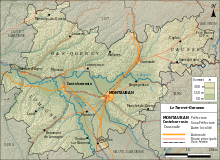Tarn-et-Garonne
Tarn-et-Garonne (French: [taʁn e ɡaʁɔn] ⓘ; Occitan: Tarn e Garona [ˈtaɾ e ɣaˈɾunɔ]) is a department in the Occitania region in Southern France.
The department is mostly rural with fertile agricultural land in the broad river valley, but there are hilly areas to the south, east and north.
[4] The kings of both England and France around this time tried to curry favour by adding to the privileges of the towns and the district.
During this time the divide between the rich and poor increased; in Montauban, hundreds turned to begging as wages fell, factories closed and food prices rose; rioting was widespread and the home of the mayor was stoned by building workers in 1847.
It borders on the departments of Lot to the north, Aveyron to the northeast, Tarn to the east, Haute-Garonne to the south, and Gers and Lot-et-Garonne to the west.
[9] The central part of the department is a broad river valley that does not exceed 150 m (492 ft) in altitude, but near the commune of Valence-d'Agen, in the extreme west of the department, the valley narrows as the hilly regions of Bas-Quercy to the north and Lomagne to the south draw closer together.
In the northeast of the department is higher land in the form of limestone plateaus known as the Causses, part of the Massif Central.
As of 2019, there are seven communes with more than 5,000 inhabitants:[3] The economy of the department depends mainly on agriculture but there is also some industry, and it benefits from its proximity to Toulouse.


